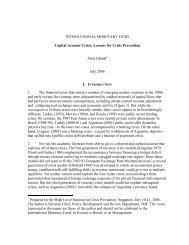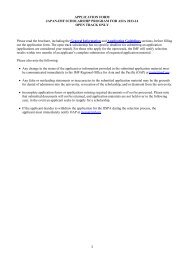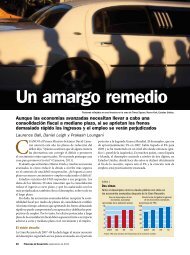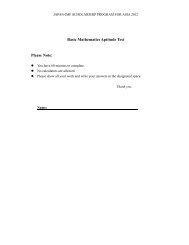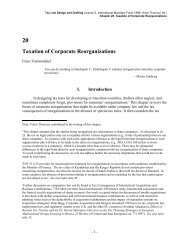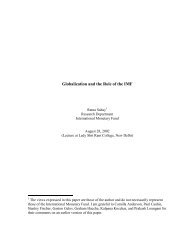Insolvency â why a special regime for banks? by Eva Hupkes ... - IMF
Insolvency â why a special regime for banks? by Eva Hupkes ... - IMF
Insolvency â why a special regime for banks? by Eva Hupkes ... - IMF
Create successful ePaper yourself
Turn your PDF publications into a flip-book with our unique Google optimized e-Paper software.
exercise broad discretion to decide whether or not to close a bank 36 , while insolvency law<br />
defines narrowly the specific conditions that must be satisfied be<strong>for</strong>e proceedings can<br />
commence. A trigger point under insolvency law is when the debtor institution has ceased to<br />
meet its liabilities as they fall due. 37 In the case of banking, however, the inability to honor a<br />
liability is not necessarily proof of insolvency, and may be due to a temporary shortage of<br />
liquidity (which, in and of itself, may reveal a violation of legal liquidity requirements and<br />
constitute an early indicator of solvency problems). Thus, the insolvency concept under<br />
general law proves somewhat dysfunctional <strong>for</strong> <strong>banks</strong>. The regulatory determination that the<br />
bank’s capital is impaired generally occurs be<strong>for</strong>e the determination of insolvency, as it is<br />
understood according to insolvency law. 38 Another facet of <strong>banks</strong> that renders the application<br />
of general corporate insolvency concepts more difficult is that, unlike other companies, <strong>banks</strong><br />
- even while experiencing financial difficulties - can continue paying creditors because they<br />
typically have an on-going source of cash flow from, and no on-going payment obligations to,<br />
depositors. Since it is the role of the bank supervisor to assess the bank’s capital and to<br />
evaluate the quality of its assets, it is also the bank supervisor who determines at what point a<br />
bank is no longer viable and must be closed; in other words, “a bank is insolvent when the<br />
supervisor says it’s insolvent.” 39 Thus, insolvency is not the first relevant trigger <strong>for</strong> bank<br />
intervention. In fact, once a bank is proven insolvent, it would be too late to intervene<br />
effectively. It is the purpose of prudential regulation and supervision to ensure a close<br />
monitoring of a bank’s financial condition. Growing financial losses, management failures<br />
and shortcomings of internal systems and controls should prompt the supervisor to intervene<br />
be<strong>for</strong>e such weaknesses develop into a situation where the bank becomes overindebted and<br />
creditors incur losses. This is the raison d’être of prudential regulation and supervision. Given<br />
this involvement of the bank supervisor in evaluating assets and determining solvency, in<br />
many jurisdictions it is the bank supervisor who has the authority, to the exclusion of<br />
individual creditors, to initiate insolvency proceedings. The banking laws of Austria,<br />
Germany and Luxembourg, <strong>for</strong> example, reserve to the supervisory authority the right to<br />
petition <strong>for</strong> bankruptcy. 40<br />
Rules are there<strong>for</strong>e needed to clarify the applicable <strong>regime</strong>, whether general insolvency law or<br />
specific banking legislation. Such rules would reconcile the grounds <strong>for</strong> intervention under<br />
bank regulatory law versus the triggers <strong>for</strong> general insolvency procedures, and would define<br />
the role of the bank supervisor relative to other authorities, in particular the courts, in the<br />
initiation of insolvency procedures.<br />
36 <strong>Eva</strong> Hüpkes, The Legal Aspects of Bank <strong>Insolvency</strong> 13 (2000).<br />
37<br />
See Orderly & Effective <strong>Insolvency</strong> Procedures, Key Issues, Legal Department<br />
International Monetary Fund 1999, available via the Internet at<br />
http://www.imf.org/external/pubs/ft/orderly/index.htm.<br />
38 This is sometimes referred to as “regulatory insolvency”, see Hüpkes, supra note 36, at 13.<br />
39 William A. Ryback, in Current Developments in Monetary and Financial Law, 223 (226)<br />
(International Monetary Fund ed., 1999).<br />
40 See supra note 26.<br />
10





